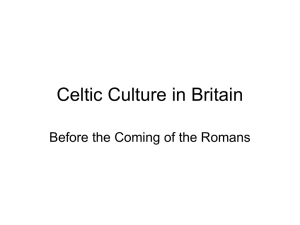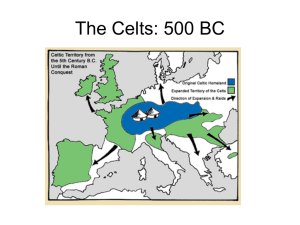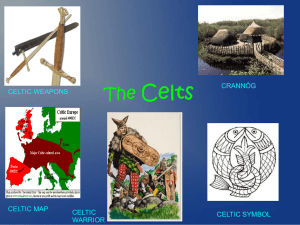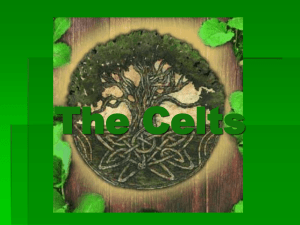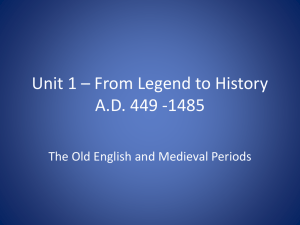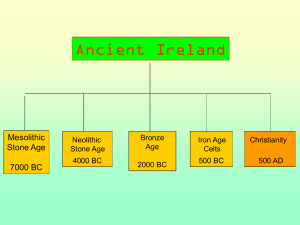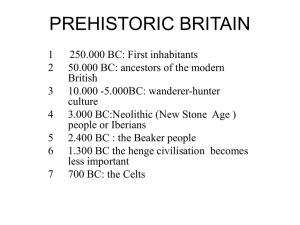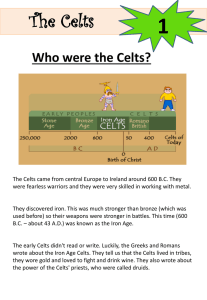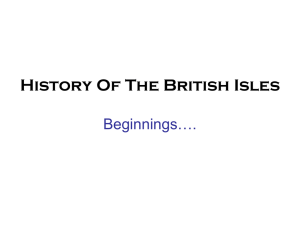Docx
advertisement
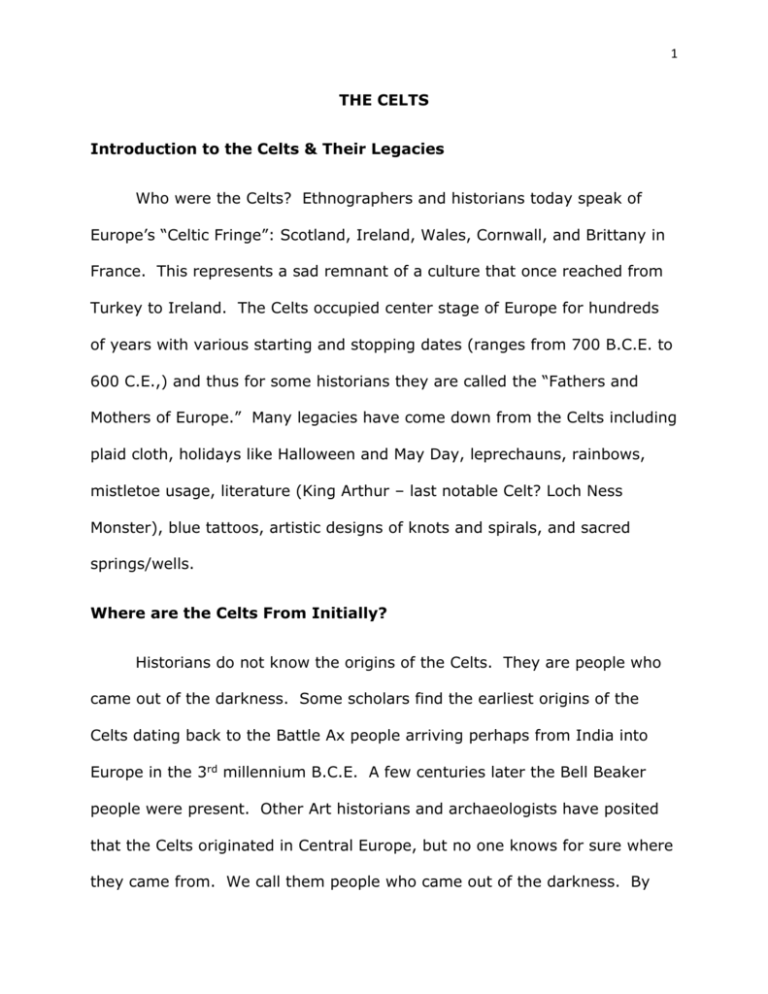
1 THE CELTS Introduction to the Celts & Their Legacies Who were the Celts? Ethnographers and historians today speak of Europe’s “Celtic Fringe”: Scotland, Ireland, Wales, Cornwall, and Brittany in France. This represents a sad remnant of a culture that once reached from Turkey to Ireland. The Celts occupied center stage of Europe for hundreds of years with various starting and stopping dates (ranges from 700 B.C.E. to 600 C.E.,) and thus for some historians they are called the “Fathers and Mothers of Europe.” Many legacies have come down from the Celts including plaid cloth, holidays like Halloween and May Day, leprechauns, rainbows, mistletoe usage, literature (King Arthur – last notable Celt? Loch Ness Monster), blue tattoos, artistic designs of knots and spirals, and sacred springs/wells. Where are the Celts From Initially? Historians do not know the origins of the Celts. They are people who came out of the darkness. Some scholars find the earliest origins of the Celts dating back to the Battle Ax people arriving perhaps from India into Europe in the 3rd millennium B.C.E. A few centuries later the Bell Beaker people were present. Other Art historians and archaeologists have posited that the Celts originated in Central Europe, but no one knows for sure where they came from. We call them people who came out of the darkness. By 2 ca. 700/600 B.C.E. their cultural distinctions had solidified into a distinctive language, art, metal working, and similar outlook on the world, including their religious tenets. This first strong evidence of a distinctive Celtic presence is the so-called Hallstatt Culture, recognizable from about 700/600 B.C.E., the center of which is the modern Austrian town of Hallstatt. Evidence of this is strictly archaeological taken from cemeteries, salt mines, and settlements. Nearby salt mines was one of the major sources of their wealth. They were also farmers, and metalworkers of iron, bronze, and gold. A few centuries later there was even wider diffusion of the Celts, including a site named La Tene that was located in Switzerland. Given the right circumstances the Celts might have united into a nation. However, they were extremely individualistic, and their primary allegiance was to their tribe. They fought one another as fiercely as they clashed with groups outside their cultures. Why are the Ancient Celts Not in World History Textbooks? In World History Textbooks, the Celts usually are given short shrift. This is probably due to a combination of reasons; Celts not believing in written records (oral transmission was used), the Anglo-Saxon belief in their superiority compared to the Irish, Scots, and Welsh, and finally the English were the primary recorders of written history in the last two centuries. The Celts are the first people of Northern Europe to be mentioned by ancient Mediterranean authors, such as the Greek writer Posidonius (circa 135 3 B.C.E. -51 B.C.E.) and Julius Caesar (100-44 B.C.E.) who is credited with conquering the Gauls (European Celts). especially fulsome. Their remarks were never Is it not strange to contemplate that we could know so little about a people so numerous? There are estimates of 5-6 million Celts at this time. Both of these ancient writers undoubtedly put their own social and political interpretations on what they recorded. Another anonymous Roman writer wrote “Nearly all the Gauls are of a lofty stature, fair and of ruddy complexion; terrible from the sternness of their eyes, very quarrelsome, and of great pride and insolence…the Gauls even drank their wine undiluted,” a sure sign of being a barbarian for the Romans always diluted their wine with water. Celtic Famous Aggressive Attacks When a group of Celts sacked the city of Rome in 390 B.C.E., the Romans never forgot this humiliation. Later on in 279 B.C.E. the Celts attacked the Delphi Oracle in Greece. The third century B.C.E. is considered the apex of the Celtic territory and power. Celtic military technology with their war chariots and iron swords devastated all their adversaries, but when Rome finally developed its legions, then one by one the Celtic Tribal Kingdoms fell to them and the Germanic tribes. After years of fighting the Gauls, Julius Caesar finally prevailed, and this led to the westward migration of Celts to Britain. By the 5th century C.E. only Britain remained a Celtic 4 stronghold. This is the time of the legendary King Arthur, who was a Celt.1 Britain was being attacked by the Angles, Saxons, Jutes, etc., and once again the Celts were forced to flee westward. Today, the country of Ireland gives us the best chance to see the residue of the Celtic traditions. Celtic Culture including fighting others Living in clans, tribes, and villages, the Celts did not think of themselves as a single people, although they spoke dialects of the same language. An individual Celt was like a member of a present-day street gang, where his allegiance was always to his tribe. And, like street gangs today, Celtic tribes often were at war with one another. Drinking, eating, and fighting were the great love of the Celts. They even had fines for obesity. Fights usually broke out at these feasts, for bragging was the modus operandi. Whether drunken brawls, cattle raids on neighboring tribes or outright warfare, Celtic mythology is imbued with stories about these individualistic fights. The Celtic grand epic Tain Bo Cuailnge epitomizes this when the men of Ulster and the Men of Ireland fight over a bull. Inciting more frenzy, the Druids would literally and figuratively stir the Celts up with rings of fire that the warriors jumped through accompanied by incantations and sacrifices to the deities. This zest for war frightened the Romans and others. Celtic women fought too: “A whole troop of foreigners would not be able to withstand a single Gaul if he called to his assistance his wife, who is 1 King Arthur will be discuss in the Chapter on the Growth of Christianity 5 usually very strong and with blue eyes.” These Celts rushed into battle, blowing trumpets and emitting blood-chilling war cries. Severed heads of their enemy were slung from their horses’ bridles and another Roman writer Polybius stated “It seemed that not only the trumpets and soldiers, but all the country around had a voice and got caught up in the cry of battle: “. . . physically they were terrifying in appearance, with deep sounding and harsh voices. “ Most of the men wore trousers and tunics, although some fought in the nude. Their bodies were tattooed with blue dye from the woad plant, and their hair was spiked with lime to keep it out of their faces during the heat of battle. They carried javelins, swords, daggers, shields, and wore armlets, helmets, and torques. The Celts believed their fighting gear possessed magical lifesaving properties. Celtic Political & legal structure A tribal chieftain or king was elected for life by the nobles. Aristocracy was achieved either by birth or accomplishments. These were the wealthy and most honored warriors. Freemen were well off farmers, bards, and highest-ranking artisans. The laborers, serfs and slaves were relegated to the lowest rung of society. Their society displayed many unique customs. Equality of women with men was evident in allowance for girls’ education, choosing a mate, ability to divorce, ownership of property, and even to fight and wage war alongside the men. Some of the women achieved the highest political power, the Queenship of a tribe. 6 As Celts were tribal, they lived in villages of thatched houses usually at the base of hills. These hills served as forts with surrounding ditches and hills for defensive purposes. The top of the hill fort served as home for the chieftain who was elected for life, and other prominent members of the community. During cattle raids and other violent attacks, the hill fort became a sanctuary where farmers and other Celts outside the walls took refuge. Over the centuries the hill forts became hubs of fortified Celtic towns. Celtic Fosterage Both girls and boys took part in fosterage, the Celtic system of education. Before the age of seven, the children were sent to foster families, usually in a different settlement. They were taught skills commensurate with their social status. Boys were taught physical and fighting skills, while girls were taught sewing and weaving as well as fighting skills. Girl’s parents paid about one-third more for their education than for the boys. These fostered children were expected to provide new bonds between their family’s groups and foster parents’ group to prevent war and robbery. Celtic Marriage & Family Customs When the girls were about fourteen, they returned to their natal families, and were ready for marriage. There is much evidence that women 7 had the right to choose their husbands, or choose not to marry. In some of the tribes the young maiden would choose her husband by offering to wash his hands. In Ireland the man wishing to marry had to deposit the right of purchase with the prospective wife’s father. In Wales, there was an additional requirement for the new husband. He had to pay the cowyll, the price of her virginity, but significantly it was paid before the first night of their marriage. 2The husband was not always the dominant marriage partner. If the wife had the greater fortune, then she was the unchallenged head of the family. Polygyny was practiced, but there was always a chief wife. There is some evidence in Scotland of polyandry. Widespread sexual freedom for both genders was another unique custom for the Celts. Even after the Celts were Christianized divorce was easy for them. Why? Marriage was a free union protected by their laws, which could always be broken. Celtic divorce was not repudiation of a wife as in Ancient Rome or Christian society, but a mutual agreement to separate. If the husband was found guilty of adultery the wife could immediately obtain the dissolution of the marriage, although in some tribes the wife could be killed for adultery. Celtic Religious practices The religious practices of the Celts are difficult to reconstruct as they were mostly Christianized by the time Celts recorded their own history. We 2 This was another indication of the equality of the genders for the Celts. In the Germanic culture a present to the new bride was given only on the morrow after the wedding night, the morgengabe idea. 8 do have some Roman primary sources discussing their deities, and there is even evidence that the Romans borrowed some of the Celtic goddesses. The druids were the priesthood, and were composed of both men and women. Their function was to memorize, preserve, and recite on request ancient laws, genealogies, epics, myths, and memories of their people. These druids clung to their monopoly over the collective tribal memory, and thus they did not reduce this ancient lore to writing as this would have deprived them of their functions as recorders of the past. It is thought that the druids could read and write Greek and Latin, and their apprenticeships lasted nearly twenty years, what is considered the full cyclical time of the moon. As the druids were peripatetic and not necessarily tied to one tribe, they held worship services that were designed to appease the gods and goddesses, in natural settings of the forest. It is thought that the oak tree was sacred to these druids, and that mistletoe that grows on these mighty trees was also revered by them because it possessed magical powers to heal humans and even to imbue them with fertility. Occasionally, humans were sacrificed presumably using criminals or prisoners of war. We have archaeological evidence of this human sacrifice found in the peat bogs in England. The most famous is called the Lindow Man, who was found in 1984 in Cheshire, and he is now displayed in the British Museum in London. It is estimated that he was sacrificed ritualistically using garroting, stabbing, and finally drowning. 9 Celtic Veneration of the Human Head and other Specific Beliefs No object was more venerated than the human head for the Celts. They thought that the head was the center of the soul, and contained the essence of the individual. The soul survived the death of the body, and furthermore the Celts believed that a severed head could move, speak, sing and ward off evil. Thus, heads of those vanquished in battle were highly prized and kept as family heirlooms, even serving as drinking cups after decorating them. The number three was also sacred to the Celts and there are many surviving artifacts that have a three sided head and three statues at a well. Water also had special meaning for the Celts, and many artifacts have been found that were probably deliberately thrown into the rivers and lakes. Celtic Religious Festivals and Primary Deities There were four great Celtic festivals, Imbolc, Beltane, Lughnasa, and Samhain, celebrated on February 1, May 1, August 1, and November 1. When the Celts became Christianized two of these holidays were adopted by the church, February 1st became Candlemas Day and November 1st became All Saints Day with the night before celebrated as Halloween. May Day was never accepted by the Christians. The Celts worshipped a variety of gods, numbering over two hundred. One of the greatest was Lug, a magician who practiced all the useful and decorative arts; playing the harp, writing poetry, 10 building houses, and forging iron for winning battles. Lyon, France or the Roman Lugudunum, and Ludgate Hill in London came from Lug. Irish leprechauns and fairy shoemakers also come from him. The White Horse of Uffington in England may be a depiction of the Celtic Goddess Epona. The White Horse is about three hundred meters wide and is carved out of a hill that exposes the white chalk stylized horse. Other artifacts of Epona show her on a horse with a cornucopia. Romans because of their use of horses for the cavalry adopted this goddess. Another popular deity with the Celts was the triple goddess Bridget.3 She was in charge of water, artistic crafts, and blacksmithing. Later on when the Celts became Christianized, they converted her to St. Bridget, who established a nunnery in Ireland, where a sacred flame was never allowed to go out. Celtic Art Celtic art is one of their most distinguishing characteristics. One of the most productive periods began about 450 B.C.E., which was later known as La Tene by art historians. Celtic art is intricate with highly stylized whorls, spirals, and curling tendrils. Though incorporating borrowings from the Greeks, Etruscans and others, Celtic art is very distinctive and imaginative. Later on their artists made beautiful illuminated manuscripts when they became Christian, such as the Book of Kells. 3 There are many spelling versions of her name, and also many interesting myths connected with her that attest to her popular standing with the Celts. 11 In the section on the Roman Empire, there will be a discussion of the Roman conquest of Britain, with the notable story of Boudicca, Queen of the Iceni, who almost succeeded in beating the Roman legions stationed in England.
